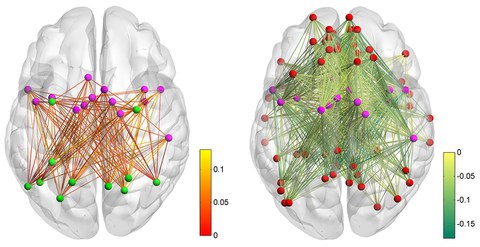Nov 04, 2016
Brain scientists at TU Dresden examine brain networks during short-term task learning – Publication in Nature Communications

Increasing communication between the cingulo-opercular network and the dorsal attention network (left side), and decoupling of the default mode network from the cingulo-opercular network (right side) during short practice phases.
“Practice makes perfect” is a common saying. We all have experienced that the initially effortful implementation of novel tasks is becoming rapidly easier and more fluent after only a few repetitions. This works especially efficient when we are guided by explicit instructions. A team of researchers at TU Dresden has now examined the underlying neural processes in a current imaging study. The results of the study are published today in the prestigious scientific journal “Nature Communications” under the title „Integration and segregation of large-scale brain networks during short-term task automatization”.
Within the collaborative research center 940 ‘volition and cognitive control’ sponsored by the DFG (German Science Foundation), the brain scientists Holger Mohr, Uta Wolfensteller, and Hannes Ruge from the Department of Psychology at Technische Universität Dresden (Germany) in collaboration with colleagues from the USA and Switzerland examined the neural processes responsible for the automatization of instruction-based tasks. Their research approach embraced the currently popular assumption that mental functions like memory or language do emerge from specific patterns of communication within and between subnetworks of the brain. Going beyond this basic assumption, it was examined whether a rapid reorganization of these communication patterns is possible – specifically during the rapid instruction-based automatization of novel tasks. Previous studies in this context mainly focused on long-term changes.
The results of this current study suggest that rapid instruction-based task automatization is facilitated by rapidly increasing communication between subnetworks associated with the transformation of visual information into motor responses. At the same time, this is accompanied by a release of network resources initially serving the controlled and attention-demanding implementation of the instructed task – while the so-called default mode network is increasingly decoupled from task-related networks. Together, these findings suggest that rapid instruction-based task automatization is indeed reflected by a rapid system-level reorganization of network communications distributed across the entire brain.
Please find the complete paper at: http://www.nature.com/articles/ncomms13217
Media inquiries:
Holger Mohr
Tel.: 0049 351 463-42432
https://tu-dresden.de/mn/psychologie/allgpsy/die-professur/mitarbeiter/utawolfensteller/agneuro
